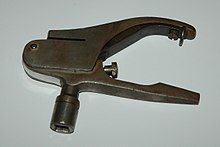Conductor's tongs

A ticket punch , also called control pliers, a nipper for canceling of value documents such as tickets or tickets or for marking test labels .
There are two basic types of conductor tongs:
- Punch pliers punch holes in the value receipt or the test label,
- Stamp tongs left a stamp on the value document.
Punch pliers
Conductor's pliers that punch a hole in a value slip are the original version of conductors' pliers. A round hole is usually punched with a round mandrel. Depending on the receipt, pliers with different jaw depths (from around 10 mm to around 80 mm) are used.
In order to be able to distinguish the inspectors or the conductors who have marked a voucher with the conductor's tongs, so-called style symbols were introduced. Shaped perforations are all perforations that deviate from the round perforations. Depending on the manufacturer of the conductor's tongs, up to 1000 shapes are possible.
Additional options for differentiation result from additional embossed marks and embossed numbers. In addition to the hole, a symbol or number is then stamped into the value slip by the pliers.
Conductor tongs as punch pliers are mainly used today to mark the date of the current or the next test on test labels (e.g. for electrical equipment, industrial trucks , fire extinguishers or power-operated gates). Furthermore, these pliers are still used today to validate entry tickets for multiple entries or so-called point tickets.
Punch pliers
Stamp tongs are mainly used to validate tickets. You leave a stamp on the ticket. At Deutsche Bahn, the stamp imprint contains the pincer number, the current date, the train number and the number of the regional area or home station of the train attendant.
Web links
Individual evidence
- ↑ Fasson sign for the low-pliers , GIF file, accessed on 13 December 2012

